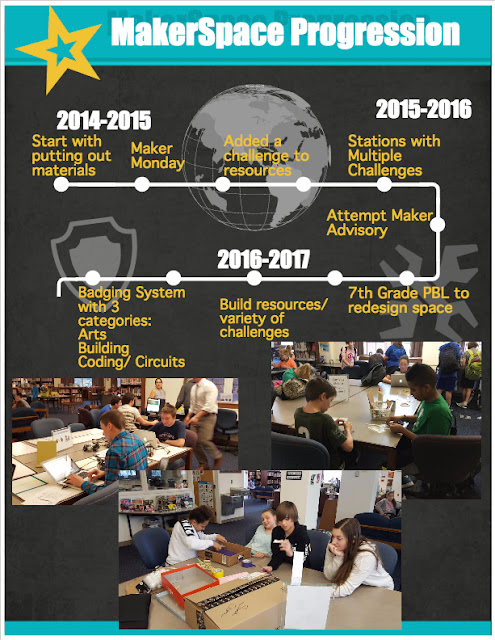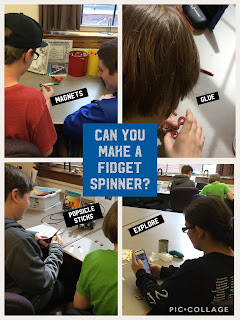We have come a long way in our MakerSpace since the inaugural 2014-2015 school year. We started small and made it manageable, so that it could also be sustainable. I am so invested in inquiry instruction and my need to focus on collaborative teaching opportunities that I didn't want to build a MakerSpace and expectations that I couldn't maintain. I believe that this progression has actually allowed our MakerSpace to grow organically and naturally, gaining momentum as students and our school community catch the vision and understand the possibilities of a MakerSpace.

The progression in our space is outlined in the Infographic shared here. We have also attempted to incorporate collaboration, and are still working on this element. I would love to have an active MakerSpace Advisory with students, faculty, and community members, but I have not yet been able to figure out the logistics of this kind of group.
This winter and spring we seem to have reached a tipping point in the MakerSpace though, with students coming to me with project ideas, asking for specific resources and training to be able to engage in making that is meaningful to them.
Our space is beginning to transform, with some of the furniture selected through the 7th grade project, arriving and changing the look of our MakerSpace. The clear drawers of the mobile carts made a big impact, with students feeling empowered to access resources themselves and becoming self directed in their making. I am excited to see it all come together, as the rest of the furniture arrives.


I am working to keep up with the student requests in the MakerSpace, and to facilitate the self direction of making, by building a Badging System. As I generate new projects I am using a template and project pattern that can become a "Library of Badges". In addition, I have enlisted the help of our technology specialists to build a system for tracking student badges and displaying a MakerSpace Leader Board in the library learning commons. We have been using the language of badging and the Badge Project Sheets for the last few months, as a kind of soft launch to this idea. I am also creating 10 Summer Maker Kits for students to check out over the summer, which incorporate project ideas, materials, and books to explore. The kits, which range from "Fashion Design" to "Music Making" to "Arduino Coding" to "Weaving" will become 10 additional badging options, which can easily be pulled for students to work on


independently during the year as well. Inside each kit are 3-4 project challenges or ideas, with basic materials to get started, and links to additional resources. These kits and badges will be launched full force over the summer and into the fall. I needed to generate enough options to make it sustainable before bringing it to students. My hope is that this will add motivation to complete and share projects as students catch a vision for the MakerSpace Leader Board.
My next focus and challenge for the MakerSpace will be getting an
Advisory group off the ground. My first priority is to get students engaged in the planning and direction of this space, but I would also love to have faculty and community members involved. There is such a wealth of knowledge and skills that I would love to see shared with our students. In addition I am looking for opportunities to add a global purpose to our making. I would love to find "real" challenges and problems that our students could be working on during their time in the learning commons.

The possibilities with MakerSpace are endless, which is so exciting, but can also become overwhelming. It has been incredibly important for me to explore what others are doing, glean ideas, and be inspired by all the making happening out there in and outside of schools. I attended the NY State Maker Summit in Albany this spring, which was a great opportunity. I continue to spend hours on Pinterest gathering ideas and inspiration, and am constantly encouraged by the blogs of other librarians and makers. Through the resources for this project I will be adding #makered to my Tweet Deck to use as another resource.






